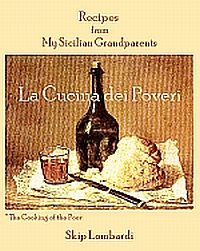Pasta al Sugo Finto
October 16th, 2007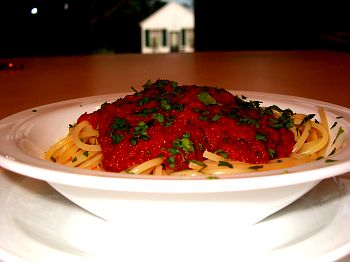
I‘ve been jonesing for Sugo Finto, literally, fake sauce, since I read the most recent menu of Mario Batali’s flagship restaurant, Babbo. Apparently Mario’s latest Tasting Menu features transcendent Duck Tortelli with Sugo Finto.
Duck is an iffy proposition at the mega-stores here on the Sun Coast of Florida, but the ingredients for Sugo Finto are available everywhere. Besides, Sugo Finto also tastes pretty good on pasta gnudi, plain pasta.
The common translation for Sugo Finto is ‘meatless ragù,’ probably derived from the fact that it’s a tomato sauce cooked for nearly as long as a traditional meat sauce. Sugo Finto begins with a batutto of garlic, carrot, celery, onion, and parsley. But unlike traditional batutto, this mixture is cooked to the point at which it caramelizes. The pot then gets deglazed with red wine and tomatoes. Herbs go in, and the sauce simmers gently for approximately an hour. The result is rich, intense, and could easily hold its own in the presence of a duck. But as I said, it’s pretty good on plain pasta, too.
Pasta al Sugo Finto
Pasta with ‘meatless’ meat sauce
Ingredients:
For the Batutto
2 – 4 Cloves garlic, peeled
1 Medium carrot, peeled and roughly chopped
1 Medium stalk celery, roughly chopped
1 Medium onion, peeled and quartered
1/2 Cup flat-leaf Italian parsley, leaves and stems
For the Sauce
Extra-virgin olive oil
1 Cup dry red wine
2 28 Oz. cans Italian plum tomatoes, preferably San Marzano
Approximately 1 cup loosely packed chopped herbs: parsley, basil, rosemary, sage, thyme, nepitella, etc.
Salt & freshly ground black pepper
1 Lb. Spaghetti
4 Tbs. Flat-leaf Italian parsley, finely chopped
Freshly grated Parmigiano
Preparation:
Place the garlic, carrot, celery, onion, and parsley in the bowl of a food processor. Pulse approximately ten times at one second per pulse. Scrape down the sides of the bowl if necessary, and pulse once or twice more.
Heat a 4 quart pot over medium-high heat, then add enough olive oil to lightly the bottom. Add the batutto and stir to distribute evenly in the pot. Lower the heat to medium, and cook, stirring occasionally, until the mixture begins to caramelize.
Raise the heat to high, and add the wine. Cook for three or four minutes over high heat to evaporate the alcohol and to reduce the wine by approximately twenty percent.
Lower the heat to medium-low, then add the tomatoes, breaking them up with the back of a fork as they go in. Add half the herbs, season with salt and pepper, and allow the sauce to simmer gently for approximately an hour. Stir in the remaining herbs, and remove from the heat.
In the meantime, as the sauce nears completion, bring a large pot of water—at least six quarts—to the boil. Add the spaghetti, and cook just to the al dente state. Remove from the stove and drain in a colander.
To Serve:
Serve family style by pouring the pasta on a platter, ladle sauce over the top, and garnish with the parsley. To serve individually, divide the pasta equally among four plates, ladle a dollop of sauce on top, and garnish with the parsley.
Pass the Parmigiano separately at the table.
Celebrating Christopher Columbus
October 9th, 2007Our celebration of Columbus Day took place at home rather than at the mall. No big-box stores or car dealerships. No “On Sale! 50% off!” for us. We paid tribute to the Genoese origins of that “big Italian fellow,” as Calvin Trillin has called him. For dinner last night we made Linguine al Pesto.
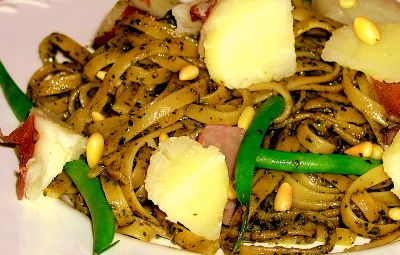
Cheap local ingredients—foraged pine-nuts, and what might have been one’s own cheese, olive oil and garden basil—gave the cooks of Genoa all they needed to make Pesto alla Genovese, the sauce for their signature dish, Linguine al Pesto con Patate e Fagiolini. Note the inclusion of boiled potatoes and string beans…
Potatoes were not there in Columbus’s time, and indeed, did not really make it into mainstream Italian cooking until the 19th century. When they did spread, from the Peruvian Andes to the botanical gardens of Mediterranean aristocrats and finally out into wider cultivation, they were looked upon more as a vegetable to serve with pasta than as a starch to replace it. But one might argue that without Columbus, the potatoes might never have been there at all, so the dish is a subtle nod to some fortuitous fusion—a once-exotic New World vegetable meeting up with Old World frugality.
As for the delicate young string beans? Hard to pin down dates for that; beans were found in both hemispheres long before the Age of Exploration. Regardless of how this particular dish evolved, the combination of those beans with new potatoes, basil pesto and pasta is sublime.
Myriad permutations are to be found—pumpkin seed pesto, arugula pesto, cilantro and citrus pesto… pesto soy burgers… But none surpass the Ligurian original. (By now, you may be wondering why we’re posting this pesto article here on Sarasota Soundings and not on our blog devoted to Italian-American food. The reason is that the recipe which follows is not Almost Italian, but really is Italian.)
Here in America the ingredients for the classic pesto are no longer cheap, but you’ll find that a little pesto goes a long way.
Linguine al Pesto con Patate e Fagiolini
Linguine with Pesto, Potatoes, and Young Green Beans
Ingredients:
4 Medium thin-skinned potatoes (such as Red Bliss )
1/2 Lb. Fresh string beans (as small as possible)
1 Lb. Linguine
3 Cups large basil leaves, loosely packed
2 Cloves garlic, peeled
2/3 Cup pignoli (pine nuts), plus 3 Tbs. for the final garnish
1/2 Cup freshly grated Parmigiano
3/4 – 1 Cup extra virgin olive oil
Preparation:
Bring a large pot of salted water to the boil. Add the potatoes and green beans, and cook until all are tender. Note: the beans will be done in only a few minutes, so remove them with tongs or a slotted spoon when they are done to your taste. Refresh beans under cold water (so they will retain their vivid green hue) and set them aside. When the potatoes can be easily pierced with a sharp knife, remove them and reserve.
If needed, add more water to the pot and bring it back to the boil. Add the linguine to the pot, stirring until the strands are submerged. Cook until it reaches the al dente state.
Meanwhile, place all the pesto ingredients, except the olive oil, in the bowl of a food processor. Pulse ten times for approximately one second each pulse, until the ingredients are finely minced. Scrape down the sides of the work bowl, then—with the machine running steadily—add the olive oil in a slow stream, pausing to scrape down the sides of the bowl if necessary.
Continue adding olive oil until the mixture develops the consistency of a thick sauce.
When the linguine is cooked, remove the pot from the burner and drain pasta in a colander.
To Serve:
Cut the potatoes into wedges. Add them along with the green beans, and approximately two tablespoons of the pesto, to a large bowl. Toss to coat the potatoes and beans. Add the pasta and the remainder of the pesto. Toss again to combine all. Using tongs, or two large forks, divide the mixture equally among four plates.
Garnish each serving with a sprinkling of the reserved pignoli.
Serves four.
Palmetto-Roasted Peppers
May 13th, 2007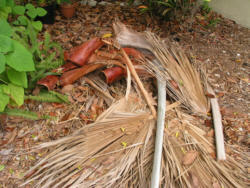
One of the great culinary finds for me here in Sarasota has been palm fronds. It turns out that they make excellent fuel for the Webber grill.
Of course, the price is right, and availability is no problem. I rarely need to forage farther than the street where I live to find an adequate supply. Once cut to size, the ribs and bases of the palmetto ignite with a piece of crumpled newspaper, and they burn at a very high temperature.
I’ve found one drawback, and that’s predictability. It seems some palm fronds burn faster than others. So I’ve remedied that by adding a half-dozen hardwood charcoal briquettes to the fire.
For grilling meats, the smokiness is great. I find it as distinctive as hickory or maple. But I’ve found another characteristic of palmetto that is unparalleled in my previous experience: it’s superb fuel for roasting bell peppers.
I’ve had problems in the past with either all hardwood briquettes, or with various other types of wood, where the peppers’ skins would simply fuse with the flesh. In five batches of peppers of varying size and thickness now, the charred skin peels off quickly and easily. In fact, for me anyway, palmetto has given new life to an Italian classic.
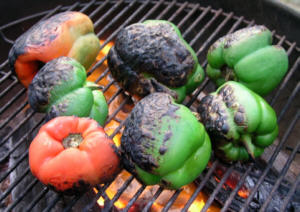 Roasted peppers are a staple of the southern Italian antipasto platter we all know, but they also make a terrific addition to sandwiches such as a panino prosciutto and mozzarella. Tony restaurants have recently been featuring roasted peppers in soups with tomato and basil. Roasted peppers are also the sine qua non for a dish of Pasta alla Napoletana.
Roasted peppers are a staple of the southern Italian antipasto platter we all know, but they also make a terrific addition to sandwiches such as a panino prosciutto and mozzarella. Tony restaurants have recently been featuring roasted peppers in soups with tomato and basil. Roasted peppers are also the sine qua non for a dish of Pasta alla Napoletana.
Roasting peppers is not rocket science. You need only a charcoal grill or a broiler to roast peppers. Then it’s just a matter of shepherding them though the process. This is a time, though, to give complete attention to the task at hand.
One moment too long on the grill yields pepper-flavored charcoal. So let the phone ring through to voicemail, and free yourself from other potential distractions for several minutes, and you’ll be rewarded with one of the great treats of the Italian table.
Notes:If you’re using palm fronds, use the ribs and base only. Cut the top, leafy part away, and bring it to the curb on yard waste day.
In the recipe that follows, I’ve simply made reference to a charcoal fire. Of course this will work with all charcoal, or under the broiler in your kitchen too.
Ingredients:
4 – 6 Sweet bell peppers
4 Cloves garlic, peeled, and thinly sliced
1 Tbs. Capers, washed, and drained
4 Anchovy filets, preferably dried, salted anchovies, rinsed, drained, and chopped into quarter inch pieces
Olive oil
Salt & freshly-ground black pepper
Preparation:
Start a fire in a charcoal grill, or pre-heat the broiler. When the fire is ready, add the peppers without crowding them. Allow them to char on the side facing the fire, inspecting them from time to time. When the skin has blackened and has begun to bubble away from the flesh, turn them to expose another uncooked surface to the fire. Continue cooking them in this manner until they are uniformly blackened all around, then, stand them on end to blacken them top and bottom.
As each pepper is done, remove it to a paper bag to rest. When the last pepper is done and added to the bag, seal the top by folding it over several times, and allow the cooked peppers to rest for fifteen minutes.
For peeling the peppers, I observe a tradition I learned from my grandfather: I open a newspaper and simply rub the skins off onto the sports section. You could do it over a sink or a wastebasket, but do it in a place where you can control where the skins go. In his later years, my grandfather was also notorious for getting charred pepper skins all over the kitchen cabinets. If you find a particularly tough piece of skin that won’t come off easily, try loosening it with the back of a paring knife; failing that, try a vegetable peeler.
When the peppers are peeled, cut off their tops, then remove and discard the seeds and pod. Cut the peppers lengthwise into strips about one inch wide and place in a glass or ceramic bowl. Add the garlic, capers, and anchovies. Toss to combine the ingredients, then add enough olive oil to coat the peppers. Don’t soak them; just coat them with the oil. Taste for salt and pepper, and add them to your taste. Leave the peppers to marinate at room temperature for two hours.
If you’re not going to use the peppers immediately, cover the bowl with plastic wrap, or transfer to a glass jar and store them in the refrigerator. The peppers will keep, refrigerated, for at least a week.
The peppers will be adequate as a component of an antipasto for twelve, or make sandwiches for six. But if there’s a good ball game on television and you have a loaf of good Italian bread and you’re all alone…well, all bets are off.
Peperoni Ripiene con Risotto
May 6th, 2007I‘ve been encouraged to discover that besides tomatoes, peppers too are in season here on the Gulf Coast of Florida. And at $0.25 each at the open air produce market, represent a great value.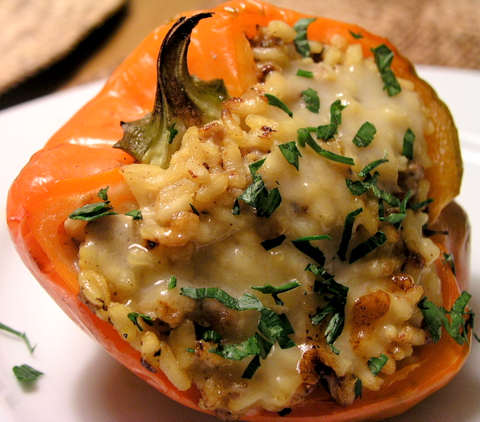
While roasting is always a good choice for bell peppers, this particular batch was colorful enough that I thought I should stuff them. But rather than use the traditional stuffing based on bread crumbs, I used a simple risotto with sausage, based on the Montovan recipe for Risotto alla Pilota.
Again, though, I wanted to keep this simple in order to keep the focus on the peppers, so rather than use chicken stock for the risotto, I simply used water.
I’ve also discovered recently that by adding the wine to the risotto last, instead of first, the risotto has a pleasant sweetness that doesn’t come through with the more traditional cooking method.
Peperoni Ripiene con Risotto
Peppers Stuffed with Risotto
Ingredients:
2 Large bell peppers
1 Tbs. Olive oil
1 Italian sausage (either sweet or hot) with the casing removed
1 Medium onion, finely diced
2/3 Cup Arborio rice
1/2 Cup dry white wine
1/4 Cup grated Pecorino Romano or Parmigiano
1 – 2 Slices sharp Provolone, shredded
4 Tbs. Flat-leaf Italian parsley, finely chopped
Preparation:
Preheat the oven to 450 F.
Slice the peppers in half lengthwise. If possible, slice through the stem as well. Remove the seeds and ribs (a grapefruit knife works well for this purpose), and discard.
Place the peppers—cut side down—on a baking pan, and then in the oven. Cook for approximately ten minutes, or until the peppers begin to wilt and caramelize. Remove from the oven and reserve.
Meanwhile, heat a sauté pan over medium heat, then add the sausage. Cook, breaking up the sausage with the back of a fork, until it has lost its pinkness, and has begun to exude some fat. Remove from the heat and reserve.
Heat another sauté pan over medium-high heat, and when hot, add the olive oil. Add the chopped onion, and sauté for three or four minutes until the onion has wilted. Add the Arborio to the pan, and sauté briefly to toast the rice.
Begin adding water to the pan, approximately 1/4 Cup at a time, stirring constantly. When one addition of water has been absorbed, add another 1/4 Cup, continuing to stir. Begin tasting the rice after approximately fifteen minutes. The grains should retain their texture, but the dish should also be creamy.
When the rice is nearly cooked, add the wine, and cook, stirring, to dissolve the alcohol. Remove the rice from the heat, and add the Pecorino or Parmigiano. Stir in the reserved sausage.
Place the reserved peppers, cut side up, on a baking pan, and spoon the risotto into each of them, just mounding the risotto slightly. Dot each pepper with the shards of Provolone, and return to the oven for five or six minutes—just until the cheese begins to bubble.
Remove from the oven and place one pepper half on each of four dinner plates. Garnish with the parsley, and serve at once.
Serves four


